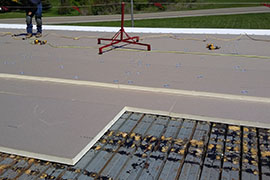Single-Ply Roofing, Georgetown KY

Single-ply roofing systems have a variety of attractive benefits that can make them a great choice for your commercial or industrial building. Rubber roofs have been around for well over 60 years and have a proven track record of performance, while TPO and PVC roofs, although newer to the game, have also proven to be durable, reliable systems.
If you are a building owner or property manager in search of a roofing solution that will perform consistently and efficiently, you should consider the advantages of investing in a single-ply membrane. Southeastern Solutions is Northern Kentucky’s single-ply roofing expert. Our roofers have many years of practical experience and industry education and expertise – we are passionate about helping our clients find the roof that is right for them. Call us today at (859) 983-0630 to learn more or read on to find out more about single-ply membrane roofing systems.
Single-Ply Roofing Basics

As their name suggests, single-ply membranes are essentially roofing systems composed of ONE layer of material. There are three main single-ply systems:
- Rubber (ethylene propylene diene monomer rubber)
- TPO (thermoplastic polyolefin)
- PVC (polyvinyl chloride)
These systems can further be divided into two other categories:
1) Thermoset
Rubber is a thermoset membrane. This means after it is installed and formed into its permanent shape with the use of a heat gun, it will remain solid from that point on. Thermoset membranes require the use of an adhesive during installation.
2) Thermoplastic
Thermoplastic membranes can be re-heated and softened over and over, allowing roofers to adjust them. Many thermoplastics are manufactured with embedded polyester or fiberglass to increase durability and stability.
Finally, there are three main methods of fastening single-ply roofing to the roof:
- Fully adhered: Uses adhesives to fully secure the membrane across the roof.
- Mechanically: Uses screws or nails or other fasteners to secure the membrane.
- Ballasting: Uses gravel or another heavy material to weigh the membrane down and keep it in place.
Benefits Of Single-Ply Roofing
Rubber, TPO, and PVC membranes vary greatly in some respects:
- Rubber comes in a range of thicknesses from 30-90 mils, giving you flexibility in look and functionality. Rubber performs well even with large temperature changes and constant exposure to harsh sunlight.
- PVC demonstrates superior resistance to tearing and breaking. It is also naturally fire resistant and extremely resilient, even in the presence of chemicals, grease, or oils.
- TPO roofing is highly resistant to debris, algae, and dirt. Its flexibility allows it to withstand punctures, tears, and impact damage.
Overall, however, there are some benefits all three single-ply membranes share:
1) Single-ply membranes are an affordable option.
Because single-ply membranes are relatively easy to install (they come in lightweight, easy-to-access rolls), you can save big on labor costs. Secondly, most single-ply membranes are naturally reflective or come with a reflective coating that bounces back a significant amount of sunlight, lowering utility costs by 30-50%.
2) Single-ply membranes are low maintenance.
Single-ply roofs require minimal maintenance, other than the industry-recommended inspection and cleaning every 6 months or so.
3) Single-ply membranes are long-lasting.
Thanks to their flexibility and durability, on average, single-ply roofs last 40 years with proper maintenance. EPDM roofing has been used for commercial flat roofing for over 60 years.
Call Today!
If you have questions about single-ply roofing systems for your commercial property, give Southeastern Solutions a call today at (859) 983-0630. We can walk you through the best solution for your unique circumstance and provide you with quality products and expert installation, all at a competitive price.
